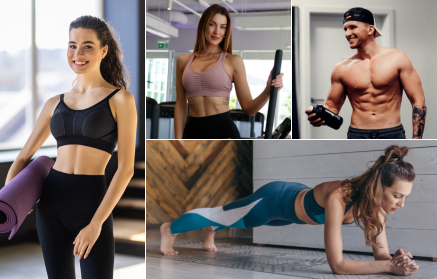Table of Contents
The plank is an exercise you either love or hate. Although most people belong to the second group, we all still incorporate it into the training plan. Those endless seconds of burning abs and the shaking of your whole body are rewarded with all the benefits it provides. However, it’s not just about staying in the plank position for as long as possible and expecting a six-pack. People make all sorts of mistakes during the plank exercise that can spoil the results. Today’s article will tell you what those are and much more.
What is a plank?
The plank is an isometric exercise that is based on maintaining a stable position for several seconds to minutes. It looks similar to the basic push-up position except that your forearms are on the ground. The body is parallel to the ground, the legs are extended and the toes are pressed into the mat. Thus, your forearms and the tips of your feet serve as a base to help you fight gravity.
Which muscles are targeted by the plank?
The fact that the abdominal muscles are primarily involved during the plank probably won’t surprise anyone. However, it targets six-pack muscles along with the muscles located deep inside. Specifically, these are:
- straight abdominal muscles(musculus rectus abdominis)
- transverse abdominal muscle (musculus transversus abdominis)
- external oblique muscles (musculus obliquus externus abdominis)
- internal oblique muscles (musculus obliquus internus abdominis)
These muscles are the basis of core and their main task during the plank is to keep the spine in a neutral position (without bending). In this way, you work on the deep stabilization system of the spine, which also includes the diaphragm, pelvic floor muscles and short back muscles in the deepest layer along the spine (musculi multifidi). In the plank position, however, the muscles of the arms and buttocks are also put to work. When you add it all up, you get a great complex exercise. [1]
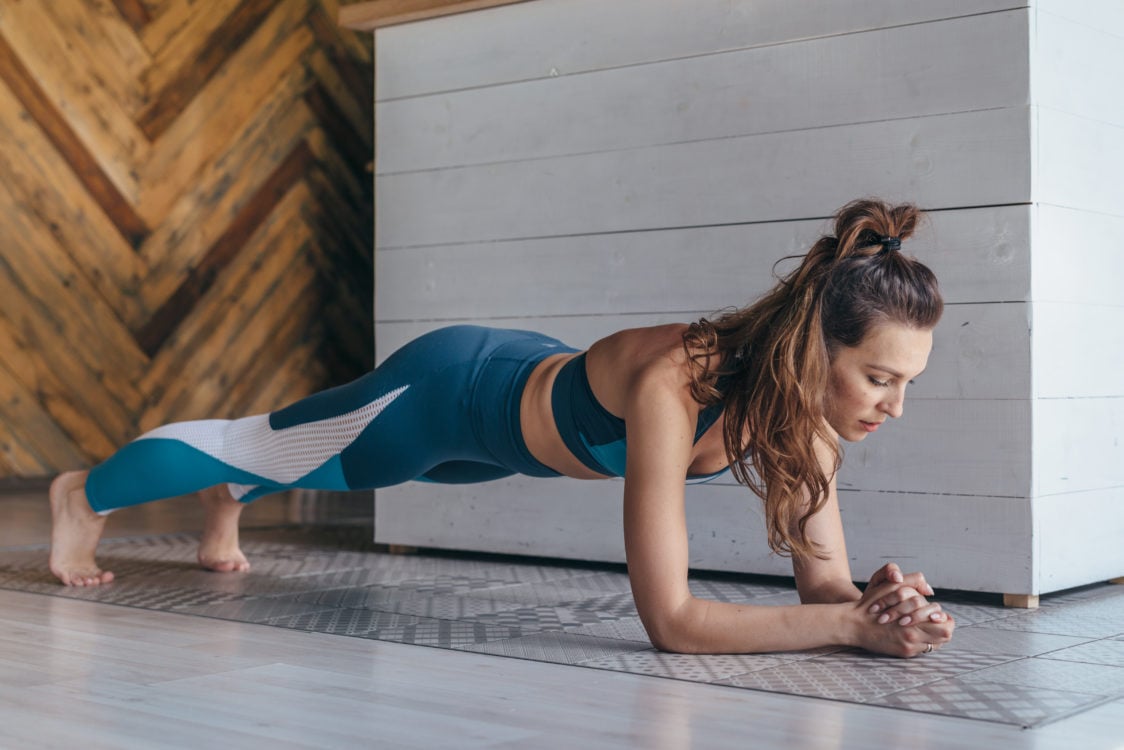
Why do the plank exercise?
If, even after reading about all the muscles that get involved, you don’t know the answer, it’s a strong midsection and, above all, a proper six-pack! The plank itself won’t help you lose much of the belly fat, but that isn’t a problem at all, because our comprehensive guide includes planks as well. Nevertheless, there are many more benefits of the plank exercise, some of which might actually surprise you.
1. You can do it anywhere
If you want to do the plank, you don’t need to buy a gym membership or some fancy equipment. All you need is your own body, a place on the ground, a pinch of determination and possibly an exercise mat for greater comfort. You can do it at home, in the garden, in a street workout park or even when you’re on your holidays.
2. Suitable for both beginners and advanced athletes
Athletes of all sorts can include the plank in their exercise plan.
- Beginners who can’t hold the plank in the correct position for even 10 seconds can safely do it with knee support. After a while, when they are more confident in this position, they can switch to the classic plank.
- The next step is time extension.
- Advanced athletes who have no problem holding a stable plank for more than 30 seconds can try even harder variations. These include, for example, a plank with arm/leg lift, plank on balance accessories or with a weight in the form of a plate on the back.
In this way, you can increase the difficulty of the plank almost indefinitely, and you will be constantly improving.
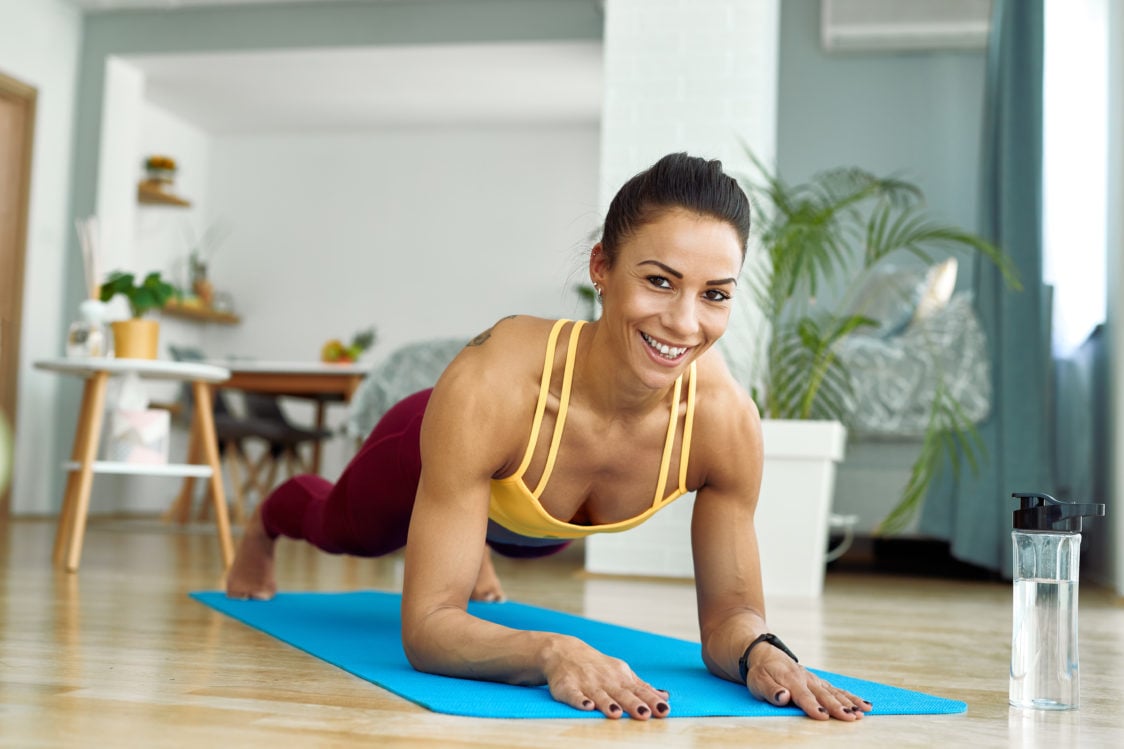
3. Improves posture and body balance
If you do the plank regularly and thus strengthen your core, it can also have a positive effect on your posture. The muscles of the middle of your body are involved in maintaining an upright torso when sitting, standing, walking and exercising. This is important not only from an aesthetic point of view, but also from a health point of view. It will help you avoid a sore and stiff back from bending over, and you will also prevent the occurrence of various muscle imbalances. At the same time, you will reduce the risk of injury during movement, because a strong core will help you maintain body stability and balance. [3–4]
If you suffer from back pain and want to know what other things might be causing it and what to do about it, read our article Back Pain: 10 Most Common Causes and Solutions to Get Rid of It.
4. Strengthens the core and helps to define the abs
As already mentioned, the muscles of the middle section of the body are intensively involved in the plank. This results in their strengthening and improvement in function. This will help you get a strong core, which takes care of maintaining a healthy position of the spine and is also the centre of strength and stability of your body. Moreover, the aesthetic benefits of a strong core should also be mentioned. After all, a firm belly and defined abs are the main reason why people do plank exercises. The exercise itself won’t get you a belly like on the cover of Muscle & Fitness magazine, but it is an important part of the puzzle of how to get those sexy abs. [2]
If you dream of a six-pack and want to learn how to achieve it step by step, read our article A Proven Guide to a Six-Pack: Diet and Training Routine for Sculpted Abs.
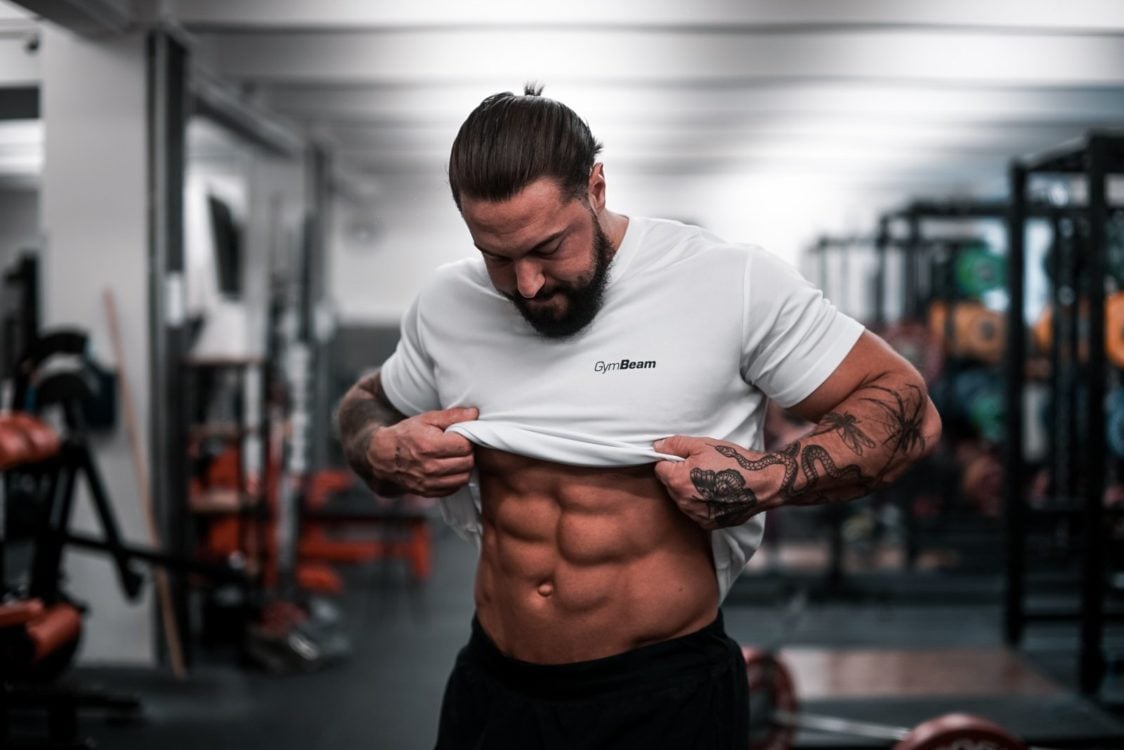
5. Improves overall strength
By doing the plank regularly, you can improve in other strength exercises as well. A strong core will help during heavy squats, deadlifts and bench press. When doing weighted squats, the activated core of the body ensures that the spine and pelvis are kept stable. This also enables efficient transmission of force to the limbs and better control of the entire movement. With proper technique, you’ll lift more weight without the risk of injury. This is also the reason why weightlifters, crossfitters and other strength athletes include the plank into their training plan. [5]
6. It can make you a better athlete
Plank is an important exercise that can bring its benefits to all athletes and not only those who lift weights. Imagine, for example, a basketball player who has to run, dribble, then make a quick move around the opposing player and slam dunk at the end. Without a strong core, that quick change of motion could cost him an injury. Even when running, hitting a ball with a tennis racket or kicking a ball, the core takes care of maintaining balance and efficiently transferring power where it is needed. This has the greatest effect on sports where there is a rapid change in movement. If you play basketball, football, rugby or do martial arts, some variation of the plank should be present in your training plan. [6]
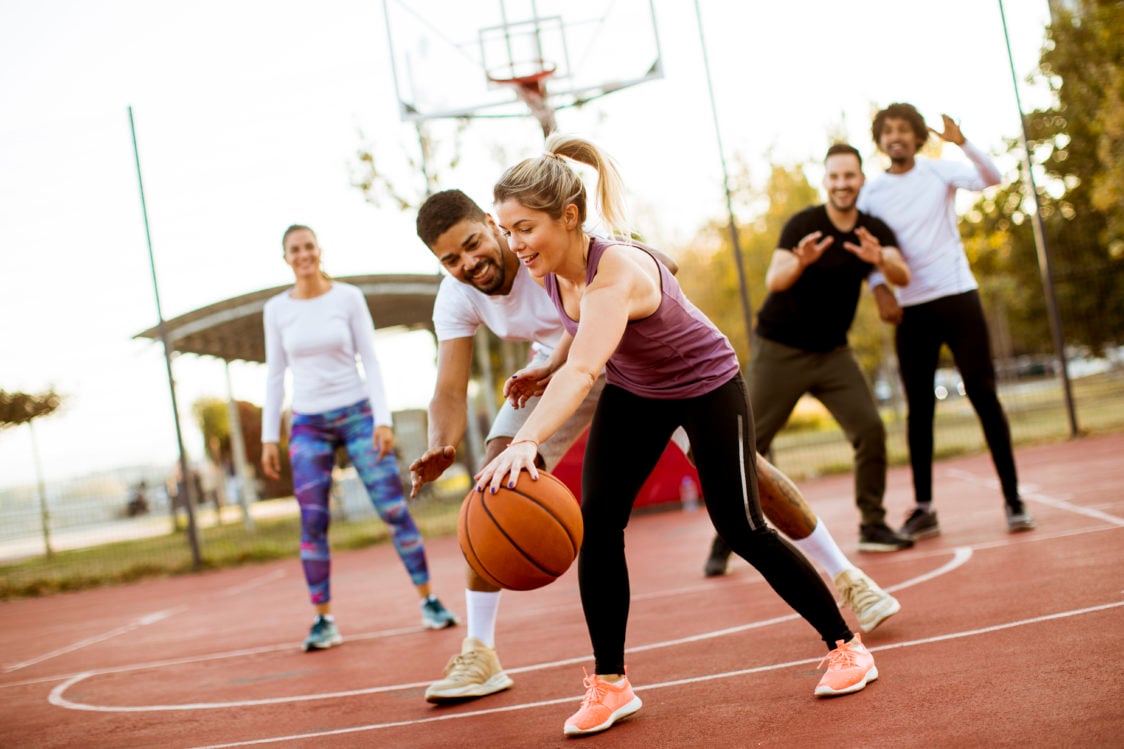
Are there any risks or disadvantages to the plank?
The plank is generally a safe exercise. However, there are some people who should avoid doing it and their training plan should be consulted with their doctor or physiotherapist. These include people with disorders of the back, spine or other parts of the musculoskeletal system. Also, because it is an isometric exercise, it can cause a rapid increase in blood pressure, which is dangerous for people with high blood pressure and other diseases of the heart and blood vessels.
Many people avoid the plank because they don’t enjoy it. Sure, holding a plank for a minute is probably not the most fun, but try thinking about all its benefits. It should immediately become a little more bearable. Alternating between different variations and styles of training (HIIT, Tabata, circuit training) and the use of aids can also help. [7]
How to do the plank correctly
How to start with planking? If you want to get the most out of the plank, you can’t do without learning the proper technique. Get a mat or a towel so that you can exercise more comfortably, and come and try it right away according to our instructions. [8]
1. Starting position
- Kneel on the floor, and lean forward on your forearms.
- Keep your hands in fists or place your palms flat on the mat. You can place your forearms parallel with your hands or move your palms together to form a triangle.
- The head and neck are an extension of the spine, draw your shoulders back and away from your ears, pull the shoulder blades slightly together and downwards. Elbows should be at approximately 45 degrees to the body.
- Keep your knees partially bent. Press the tips of your feet into the mat.
- Activate the core and try to keep your body in a straight line.
- Remember not to bend your back, especially the lumbar spine.
2. Execution
- Breathe freely, keep your body tight and try to hold this position for a few seconds.
- Focus on the elbows and toes.
- Use either a sports watch, workout timer or phone to track your time.
- Take a break the moment your hips start to sink to the floor or you can’t maintain a stable position.
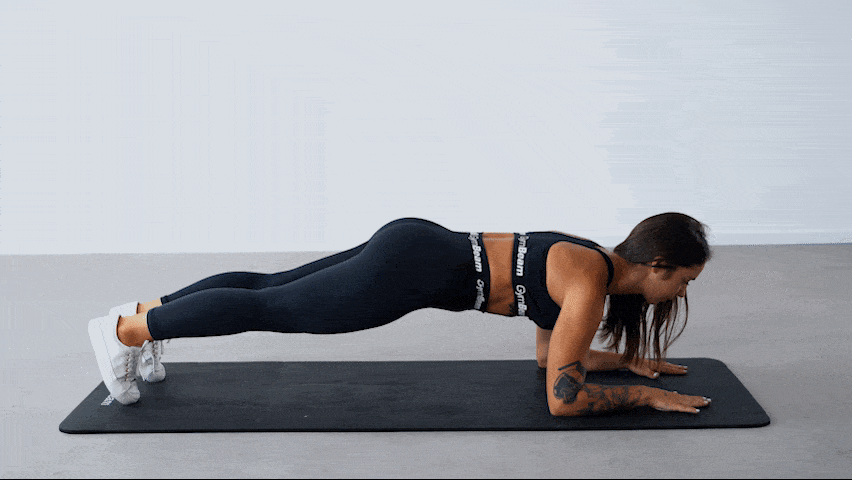
What are the most common mistakes in plank exercise?
- Arching your back: Most often the hips sink.
- Dropping the hips to the ground or excessively lifting the pelvis up.
- Winged shoulder blades: The shoulder blades should remain on the chest and the space between them filled.
- Improper position of the arms: Be careful not to push the elbows forward too much.
- Breathing: Focus on free regular breathing throughout the exercise.
- Head tilt: Look at the mat the whole time, not in front of you.
How to make the plank more challenging?
After you learn the basic plank, you can try more challenging variations.
- Plank with arm/leg lift: Lift one arm or leg, or the opposite limbs at the same time, and try to maintain a stable plank position.
- Plank with weight: You can wear a weight vest for the plank or ask a partner to put a bumper plate on your back.
- Plank on balance equipment: If you place your hands or feet on a fit ball or some balance trainer, it will immediately become more difficult to maintain this position.
- Plank with a suspension trainer system: You can hang your legs or hands in the straps and then hold the plank for as long as possible.
- You can find even more variations of the plank in the article focused on different alternatives to the classic plank.
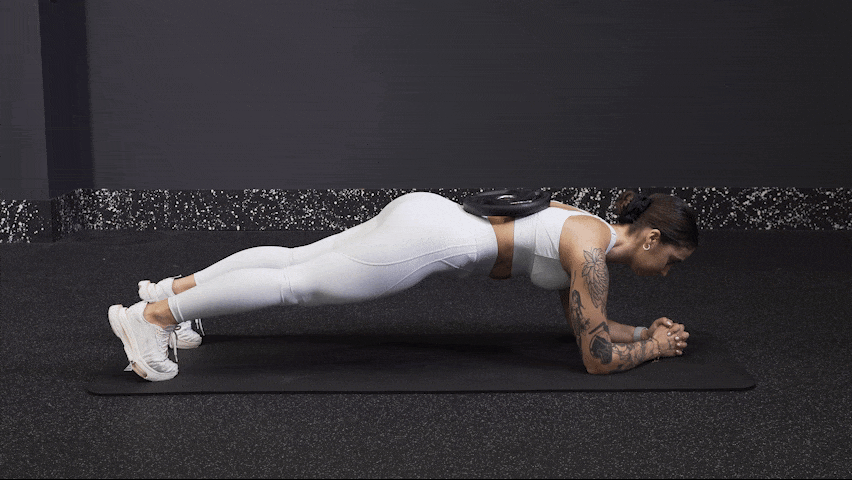
Plank in a training plan
Doing one plank challenge after another probably isn’t the best idea in the long run. In this way, you can overload the abdominal muscles, as well as shoulders, which are also involved in maintaining a stable position. It’s a much better idea to schedule this exercise wisely into your training plan.
1. Plank as part of a training plan
It’s not necessary to do the plank every day, as all the challenges try to tell you. Results will come even if you include it in training 2–3 times a week. This way you will have enough time for regeneration. You can do it either on its own or as part of an ab workout. It is also suitable for circuit training or HIIT.
Abs training is not only about the plank. It’s about a more complex approach with more exercises. You will learn everything in the article 21 Best Bodyweight Ab Exercises.
2. Plank as a separate exercise
How long to do the plank for? Try to gradually increase your endurance in the plank. Start with, for example, 15 seconds and add another 10 each week. However, increase the time only if you manage to maintain the correct technique. You can also gradually increase the number of sets, from 3 to 5.
Test your endurance in the plank
If the plank is already a regular part of your training plan, you can try the fitness plank test. It is often used by trainers to determine the level of strength, endurance and stabilization abilities of the core of their clients. The test is based on measuring the maximum endurance in the plank. Measuring starts when you get into the correct plank position and ends when your hips start to drop to the floor or your pelvis lifts. Ideally, ask someone else to measure the attempt for you. Based on the resulting time, you will then find out your current level. After some time, for example after a month of regular training, you can take the test again. [9]
Difficulty level in plank by time
Hold Time | Difficulty |
|---|---|
| Very Low | |
| 15–30 seconds | Low |
| 30–60 seconds | Below Average |
| 1–2 minutes | Average |
| 2–4 minutes | Above Average |
| 4–6 minutes | Very High |
| > 6 minutes | Excellent |
What is the current plank record?
If you were already thinking that 6 or more minutes in the plank is not humanly possible, you will probably be surprised that there are people among us who can last several hours in this position. A good example is the Australian Daniel Scali, who managed to stay in the plank position for 9 hours 30 minutes and 1 second. This made him the world record holder and as of April 2023, no one has yet surpassed him. Daniel felt even more pain than a regular person would, because he suffers from complex regional pain syndrome, which causes constant pain in his left arm in particular. It is proof that the limits of the human body are much further than meets one’s eye. [10]
Example of plank workout
You can take training inspiration directly from our example. There are 4 types of plank in it, so that you can comprehensively target the straight, deep and oblique abdominal muscles. You will alternate 30-60 second exercise intervals with 15-second rest intervals. All this in 2–3 sets, between which you include a 60-90 second break.
What to pay attention to in plank workout?
- For all variations, try to keep the body as straight as possible and pay attention to not bending the back.
- For a side plank, place your lower elbow approximately below your shoulder. You can hold your upper arm up or put it at your side. Keep your feet together and focus on keeping your hips from sinking to the floor.
- In the case of the extended arm plank, place the palms under the shoulders.
- In the plank with leg extension, lift your leg only to the height where you will be able to maintain a stable position without bending your lower back.

- If you are looking for more inspiration for abs training, you can find it in our article Effective 6-Minute Abs Workout at Home.
- If you want to focus on the lower abdomen, there are effective exercises in the article Lower Abs: 13 Best Bodyweight Exercises.
- For more tips on how to lose belly fat, check out the article 9 Tips for a Toned Six-Pack.
What should you remember?
Plank is a complex exercise that can help you on your journey to a toned and functional body. It will strengthen the muscles of the middle of your body, even the deep ones. The result is firmer abs, better posture, greater stability when standing and moving, as well as a positive effect on strength and athletic performance. However, you can’t expect it to help you get a perfect beach body in 30 days. In any case, it is worth learning how to do it correctly and adding it to your training plan.
If you liked the article and got some training tips from it, share it with your friends. They would certainly also like to learn about all the benefits and the correct technique of the plank.
[1] Physiopedia. Plank exercise. – https://www.physio-pedia.com/Plank_exercise
[2] ACE. Core Anatomy: Muscles of the Core. – https://www.acefitness.org/fitness-certifications/ace-answers/exam-preparation-blog/3562/core-anatomy-muscles-of-the-core/
[3] Dr. Atencio. The Importance of the Core in Posture. – https://texasspineandsportstherapy.com/the-importance-of-the-core-in-posture/
[4] Physiopedia. Core Muscles. – https://www.physio-pedia.com/Core_Muscles
[5] Stefan, R. Core Training for Weightlifters—How to Become Strong and Stable With the Barbell. – https://barbend.com/core-training-for-weightlifters/
[6] Tredway, T. Why Should Athletes Perform Planks? Stack. – https://www.stack.com/a/why-are-planks-worth-my-time/
[7] Admin, F. Pros and Cons of Planks—Do They Really Work? – https://www.fitnessandpower.com/training/bodybuilding-misc/the-truth-about-planks
[8] Gardner, A. How To Work Your Core With Proper Plank Form. – https://powerliftingtechnique.com/proper-plank-form/
[9] Plank Core Strength and Stability Test. – https://www.topendsports.com/testing/tests/plank.htm
[10] Guinness World Records. Longest plank record smashed with staggering new 9-hour time. – https://www.guinnessworldrecords.com/news/2021/9/longest-plank-record-smashed-with-staggering-new-time-674245

